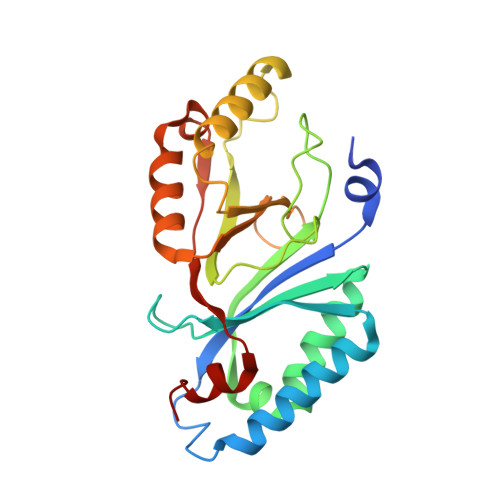Actinobacterial Coproheme Decarboxylases Use Histidine as a Distal Base to Promote Compound I Formation.
Michlits, H., Lier, B., Pfanzagl, V., Djinovic-Carugo, K., Furtmuller, P.G., Oostenbrink, C., Obinger, C., Hofbauer, S.(2020) ACS Catal 10: 5405-5418
- PubMed: 32440366
- DOI: https://doi.org/10.1021/acscatal.0c00411
- Primary Citation of Related Structures:
6XUB, 6XUC - PubMed Abstract:
Coproheme decarboxylases (ChdCs) catalyze the final step in heme b biosynthesis of monoderm and some diderm bacteria. In this reaction, coproheme is converted to heme b via monovinyl monopropionate deuteroheme (MMD) in two consecutive decarboxylation steps. In Firmicutes decarboxylation of propionates 2 and 4 of coproheme depend on hydrogen peroxide and the presence of a catalytic tyrosine. Here we demonstrate that ChdCs from Actinobacteria are unique in using a histidine (H118 in ChdC from Corynebacterium diphtheriae , Cd ChdC) as a distal base in addition to the redox-active tyrosine (Y135). We present the X-ray crystal structures of coproheme- Cd ChdC and MMD- Cd ChdC, which clearly show (i) differences in the active site architecture between Firmicutes and Actinobacteria and (ii) rotation of the redox-active reaction intermediate (MMD) after formation of the vinyl group at position 2. Distal H118 is shown to catalyze the heterolytic cleavage of hydrogen peroxide ( k app = (4.90 ± 1.25) × 10 4 M -1 s -1 ). The resulting Compound I is rapidly converted to a catalytically active Compound I* (oxoiron(IV) Y135 • ) that initiates the radical decarboxylation reactions. As a consequence of the more efficient Compound I formation, actinobacterial ChdCs exhibit a higher catalytic efficiency in comparison to representatives from Firmicutes. On the basis of the kinetic data of wild-type Cd ChdC and the variants H118A, Y135A, and H118A/Y135A together with high-resolution crystal structures and molecular dynamics simulations, we present a molecular mechanism for the hydrogen peroxide dependent conversion of coproheme via MMD to heme b and discuss differences between ChdCs from Actinobacteria and Firmicutes.
- Department of Chemistry, Institute of Biochemistry, BOKU-University of Natural Resources and Life Sciences, A-1190 Vienna, Austria.
Organizational Affiliation:

















